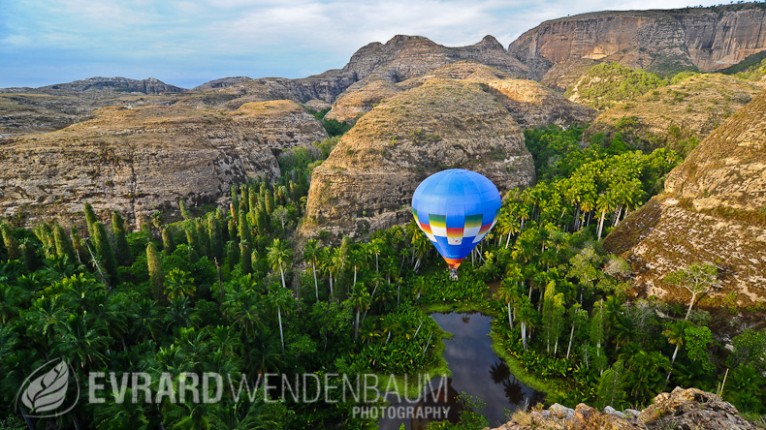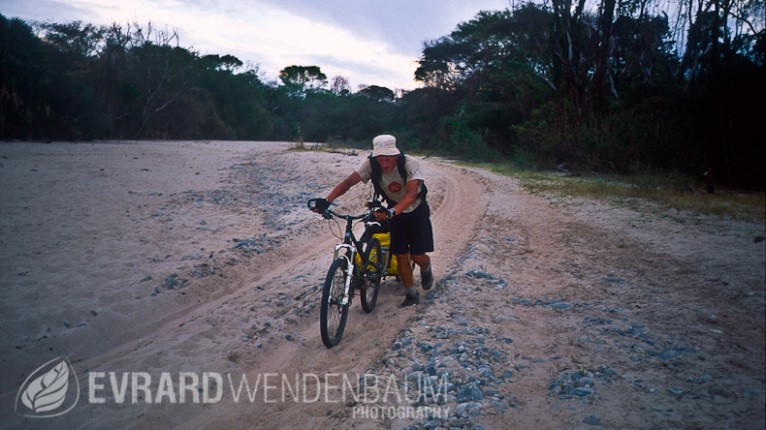In November 2001, television presenter Nicolas Hulot flew over the Makay massif in a hot-air balloon during the filming of his Ushuaia Nature programme. The aerial images are spectacular and the message is clear: no-one has ever set foot in these deep canyons, which are a treasure box of biodiversity, and there is so much to discover. Passionate about exploration and captivated by these images, photographer and scientist Evrard Wendenbaum is already dreaming of going there.

In August 2004, he set off from Antananarivo on a mountain bike for a trip into the bush, culminating in the Makay. But the tracks are sandy and he struggles to reach the villages at the foot of the massif. Lacking precise maps and guides ready to take him, he could only see the mountains from a distance. But this trip made him aware of the difficulty of accessing the massif, the bush fires that are the main threat to Madagascar’s nature and the omnipresent insecurity in the region linked to the dahalos, the zebu rustlers.

Thanks to Google Earth images, Evrard launched a new reconnaissance expedition in August 2007. The small team of 11 (3 vazahas and eight locals) is penetrating the Makay’s labyrinth of canyons for the first time. They film, photograph and record everything they can about the ecosystems they encounter, the passages they discover and the animals and plants they see. They collected more than 40 species of plants, which were then sent to the Muséum National d’Histoire Naturelle in Paris – 5 of which were identified as new – and also discovered an unexpected archaeological heritage: the first cave paintings in Madagascar.
The ecosystems encountered are varied and the landscapes sumptuous. The wealth of biodiversity is obvious, as is the archaeological wealth. But it was above all the sad discovery of the ravages of bush fires in the very heart of the massif and its deepest canyons that prompted Evrard to take action to conserve the Makay massif.
He then made the documentary “Makay, le dernier éden” based on this adventure, in the hope of finding partners for the Makay conservation project that he launched in January 2008, convinced of its inestimable biological wealth and the urgent need to protect it.
In August 2009, he and Emeric Mourot founded the Naturevolution association to support the project. Thanks to a number of private partners, in January 2010 Naturevolution launched the first scientific mission ever carried out in the Makay, taking a dozen scientists to the Makay for almost 4 weeks in the field.
The Makay’s natural environments are immensely rich, but their survival depends on the speed with which we intervene, as the threats are numerous and very strong.
From late 2010 to early 2011, Naturevolution launched one of the largest biodiversity inventory missions ever carried out in Madagascar, taking nearly 60 international scientists from all disciplines into the Makay canyons for three months.
This exceptional mission led to some magnificent archaeological and biological discoveries, as well as the first 3D adventure documentary to be released at the end of 2011.
Today, Naturevolution’s actions go well beyond the framework of the scientific expeditions and the association is deploying a holistic conservation strategy, including activities to protection and restoration of natural environments – reforestation, forest guards, environmental awareness, local economic development activities – ecotourism, beekeeping, as well as activities aimed at improving local living conditions – education, food security, medical aid, etc.
They also go beyond the Makay. Naturevolution is now turning its attention, with the same urgency caused by the extinction crisis, to other regions rich in biodiversity that are difficult to access and threatened in the short or medium term. This is particularly true of our project on the island of Sulawesi in Indonesia.

